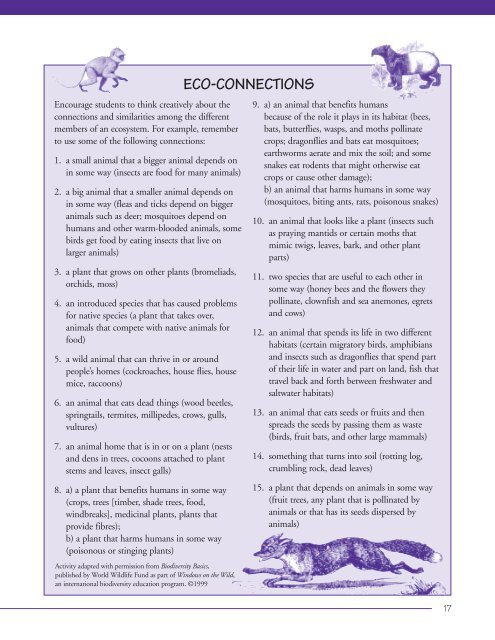EXPLORING BIODIVERSITY: A Guide for Educators Around the World
EXPLORING BIODIVERSITY: A Guide for Educators Around the World
EXPLORING BIODIVERSITY: A Guide for Educators Around the World
Create successful ePaper yourself
Turn your PDF publications into a flip-book with our unique Google optimized e-Paper software.
Encourage students to think creatively about <strong>the</strong><br />
connections and similarities among <strong>the</strong> different<br />
members of an ecosystem. For example, remember<br />
to use some of <strong>the</strong> following connections:<br />
1. a small animal that a bigger animal depends on<br />
in some way (insects are food <strong>for</strong> many animals)<br />
2. a big animal that a smaller animal depends on<br />
in some way (fleas and ticks depend on bigger<br />
animals such as deer; mosquitoes depend on<br />
humans and o<strong>the</strong>r warm-blooded animals, some<br />
birds get food by eating insects that live on<br />
larger animals)<br />
3. a plant that grows on o<strong>the</strong>r plants (bromeliads,<br />
orchids, moss)<br />
4. an introduced species that has caused problems<br />
<strong>for</strong> native species (a plant that takes over,<br />
animals that compete with native animals <strong>for</strong><br />
food)<br />
5. a wild animal that can thrive in or around<br />
people’s homes (cockroaches, house flies, house<br />
mice, raccoons)<br />
6. an animal that eats dead things (wood beetles,<br />
springtails, termites, millipedes, crows, gulls,<br />
vultures)<br />
7. an animal home that is in or on a plant (nests<br />
and dens in trees, cocoons attached to plant<br />
stems and leaves, insect galls)<br />
8. a) a plant that benefits humans in some way<br />
(crops, trees [timber, shade trees, food,<br />
windbreaks], medicinal plants, plants that<br />
provide fibres);<br />
b) a plant that harms humans in some way<br />
(poisonous or stinging plants)<br />
Activity adapted with permission from Biodiversity Basics,<br />
published by <strong>World</strong> Wildlife Fund as part of Windows on <strong>the</strong> Wild,<br />
an international biodiversity education program. ©1999<br />
ECO-CONNECTIONS<br />
9. a) an animal that benefits humans<br />
because of <strong>the</strong> role it plays in its habitat (bees,<br />
bats, butterflies, wasps, and moths pollinate<br />
crops; dragonflies and bats eat mosquitoes;<br />
earthworms aerate and mix <strong>the</strong> soil; and some<br />
snakes eat rodents that might o<strong>the</strong>rwise eat<br />
crops or cause o<strong>the</strong>r damage);<br />
b) an animal that harms humans in some way<br />
(mosquitoes, biting ants, rats, poisonous snakes)<br />
10. an animal that looks like a plant (insects such<br />
as praying mantids or certain moths that<br />
mimic twigs, leaves, bark, and o<strong>the</strong>r plant<br />
parts)<br />
11. two species that are useful to each o<strong>the</strong>r in<br />
some way (honey bees and <strong>the</strong> flowers <strong>the</strong>y<br />
pollinate, clownfish and sea anemones, egrets<br />
and cows)<br />
12. an animal that spends its life in two different<br />
habitats (certain migratory birds, amphibians<br />
and insects such as dragonflies that spend part<br />
of <strong>the</strong>ir life in water and part on land, fish that<br />
travel back and <strong>for</strong>th between freshwater and<br />
saltwater habitats)<br />
13. an animal that eats seeds or fruits and <strong>the</strong>n<br />
spreads <strong>the</strong> seeds by passing <strong>the</strong>m as waste<br />
(birds, fruit bats, and o<strong>the</strong>r large mammals)<br />
14. something that turns into soil (rotting log,<br />
crumbling rock, dead leaves)<br />
15. a plant that depends on animals in some way<br />
(fruit trees, any plant that is pollinated by<br />
animals or that has its seeds dispersed by<br />
animals)<br />
17

















